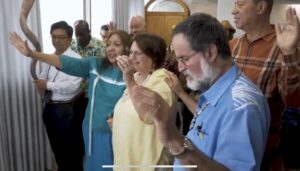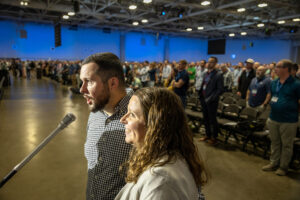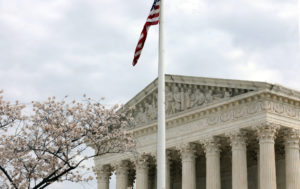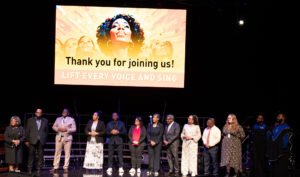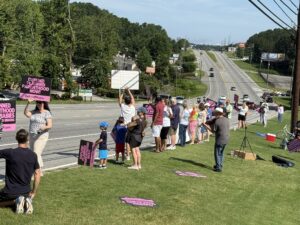
ALPHARETTA, Ga. (BP)–Following is an interview of Kevin Ezell, the new president of Southern Baptists’ North American Mission Board, by J. Gerald Harris, editor of The Christian Index, newsjournal of the Georgia Baptist Convention.
Q: I know you have indicated that looking to what occurred in the past concerning the opposition to your election is “wasted perspiration” and that it’s time to move forward, but I think our readers would like to know how you respond to criticism about your comparatively low Cooperative Program and Annie Armstrong Easter Offering giving at Highview [Baptist Church in Louisville, Ky., where Ezell has been pastor since 1996].
A: The way I describe this situation is that it’s somewhat like a guy who is dating your daughter. He wants to marry her, but you really don’t want him to. So, you do everything in your power to keep them from being married, but once they are married you do everything you can to keep them married.
I understand why some have come out against my election. I don’t blame them at all and I hope to be friends with them. But now that it has happened, the best thing for the Kingdom’s sake is that we move forward together and get this done, because that is why I am here — to try to make [NAMB] work better.
What has hurt the most in the process is the insinuation that Highview is not a giving church. I had factory workers, deacons and widows who were such faithful givers. We gave and we gave sacrificially and significantly but just didn’t go through the traditional channels.
That is why I want to be here — to give a compelling vision and an effective strategy for the North American Mission Board so people will want to give. At Highview we gave [directly] to church planters in order to be effective stewards, because we realized that through traditional giving channels not enough of the money was getting to where it really needed to go.
Q: The Great Commission Resurgence Task Force spent a lot of time assuring Southern Baptists that the Cooperative Program was the “primary and preferred” method of giving for Southern Baptists. But your church’s financial records indicate that the per capita giving is considerably lower than the average church. Do you think your election invalidates that part of the task force recommendations?
A: No, not at all. I think the search committee felt like NAMB needed to find a leader that could pull us out of where we are and take us to where we need to be. People give to a compelling vision; they don’t give to the president of an agency any more than church members give to a pastor.
I may be vulnerable at this point. I didn’t do it the traditional way, but my ultimate goal is to get people thinking about the lost. I want to make an indention upon the lost of North America and we are just not doing it right now.
I am trying to find the plumb line. For example, I want to find out how many churches are being planted and I want to know how they are doing five years later. We have got to have some accurate reporting.
I don’t want to write a book and I don’t want to start a movement after my name. I just want to get this done. I want to connect with as many state leaders as possible and I hope those state executives will give our relationship a chance. I realize I am starting behind the eight ball because some of these relationships have been strained in the past, but I want us to do it together.
Q: How do you plan to implement the ending of Cooperative Agreements between NAMB and the state conventions? How will the funds you receive be redeployed? Will they all find their ways back to states in different formulations, or will a good portion be directed to local church networks and individual congregations to plant new congregations?
A: I’ve only been doing this for three weeks. I didn’t think they would pick me [for this position] so I don’t really have a detailed plan. But this is not an either/or situation; it’s a both/and situation.
We want to partner with networks of churches, associations and state conventions and have some quality control mechanisms in place. We want to evaluate things so we won’t be sending money to churches that aren’t being effective.
I am in the process of trying to develop relationships with the state executive directors and I want to know how to relate better to them. I know some of them don’t trust me, and I don’t blame them. I just want us to all take a deep breath and give our relationships a chance; I really think it will work.
I want to sit down and listen to all the state execs and hear what they are saying. [I want them to know that] I am committed to working with our state convention leaders to penetrate lostness.
Q: Cooperative Agreements now have a high degree of accountability for how the funds are used for joint funding of missionaries and other ministries. Will you have a system of checks and balances to validate and report back to Southern Baptists tithers?
A: We have 42 state conventions and some great leaders, but I am not sure there is the same level of leadership in all 42 conventions, so there are probably 42 different levels of accountability. We need a national strategy. We want to work with the states to help provide additional accountability, because it is better to have double supervision than no supervision.
We have a Linnie Fenton principle. She was a very poor woman in my first church, [a very small church that] called me as pastor by a 7 to 0 vote. Linnie did not have much materially but she gave sacrificially. I love small churches and in every church I have served since that first one we have spent our money like it was Linnie Fenton’s money. I have always seen myself as a small church pastor that was stuck in a big church.
We are servants of the Southern Baptist Convention, of the Linnie Fentons of the world.
Q: Giving out millions of dollars to churches in $50,000 and $100,000 increments (grants) could recreate the “bloated bureaucracy” when it comes to administrative accountability that many decried SBC agencies for creating in the first place. What are your thoughts on that?
A: I can see where someone might say, “Well, he will just give money to his friends to plant churches.” What we would like to do is come up with a regional strategy. There are three primary areas that are underserved: the West, the Northeast and Canada. We would have regional supervision and they would work in partnership with those states.
We are not looking at a bloated anything. We are looking at putting more missionaries and more church planters out there, and everyone is going to have to legitimize why they are there. If people are serving in the area of evangelism we will want to know how many people are coming to faith in Christ.
I learned to witness when it was called soul winning. When I was in junior high school Bill Whitlow took me door to door in an apartment complex in Paducah [Ky.] and taught me how to be a soul winner. I used the Roman Road. I even passed out those old “Chick” tracts.
We had a bus ministry and I volunteered to be a captain, because they couldn’t find anyone to do a certain route. They would dump me at a Dairy Queen at 9 o’clock on Saturday with a big bag of Double Bubble chewing gum and I would walk around until 1 o’clock until someone picked me up. My mom and dad would give me $5 for lunch at the Dairy Queen.
But I spent four hours on Saturday morning looking for Big Wheels in driveways, because I knew that I would be able to find kids there. That’s how I learned.
We owe it to Southern Baptists to put missionaries on the field that are qualified, doing the work and serving the churches and the people. If people are serving in the area of evangelism we will want to know how many people are coming to faith in Christ.
Today there are too many people who like to push a pen rather than share their faith. I know it has got to start [at NAMB] and it has got to work its way through every floor of this building. When we meet to pray I not only want to know who needs prayer for healing, I want to know who has led someone to Christ and how we need to pray for new believers.
It will take a while to change the NAMB DNA, but we will do it through attrition, retirement incentives and infusing some of the right DNA.
Q: What kinds of churches will be started with NAMB funds that are deployed to local congregations? How will you vet each congregation for doctrinal purity? We have noticed it is not unusual for Southern Baptist congregations to put thousands of dollars into a new church plant and within five years or less it has become independent with no relationship to the Southern Baptist lifeline [the Cooperative Program], doctrine or polity. What kinds of safeguards will you have in place to prevent this from occurring?
A: We all know there is no ultimate safeguard. In fact, that is one of the reasons we started doing campuses in Louisville. We wanted to make sure that we stayed evangelistically focused and conservative theologically.
I think with the checks and balances we use and the integrity of the people we put in those churches we will help to safeguard the churches against those things that would militate against an effective ministry.
We need to make sure the churches we plant are aligned with us, but I go back to that compelling vision. We are beyond the day when people give out of simple brand loyalty. They don’t do that anymore. It’s a new generation and they love to hear about missions, but they want to do missions.
Q: Continuing that discussion of your missions giving record, you recently said that if more SBC churches followed Highview’s model there would be far more churches being planted than are currently being started. If the [Southern Baptist Convention] moved to such a model, do you see NAMB moving away from its historic role as being a missionary sending agency and shifting that role to the local church? Could you eventually see NAMB funneling more resources to church planting networks and exiting its role of recruiting and sending missionaries?
A: Highview never intended to be a model, but regarding the funding of missionaries and church planting efforts, we will need to focus on both. We will continue to send missionaries and amplify the effective efforts of churches, associations and states. I think we would be remiss to say that everything we have done in the past has been effective. Some people want to say that, but it is just not true. So, we must define reality and not miss this opportunity.
I believe we are standing at the threshold of a golden era of church planting. We have students in our seminaries that have brilliant minds, but many of them are of the opinion that it would be better to raise their own support in church planting than go through the maze of trying to get help from the denomination.
Q: First and foremost, NAMB is Southern Baptists’ missionary sending agency for the United States and Canada. In fact, NAMB’s first ministry assignment is “to assist churches by the appointment and support of missionaries in the United States and Canada” while its second directive is “to assist churches in the ministry of evangelism” and its third directive is “to assist churches in the establishment of new congregations.”
You will serve as the agency’s primary fundraiser — especially for the Annie Armstrong Easter Offering — and speaker for missionary commissioning services. Apart from the answer you gave earlier to a theoretical situation, do you think we need more missionaries, or fewer?
A: I think we need as many effective missionaries as we can possibly get, but I am not as concerned about quantity as I am effectiveness. We will start as many churches and put out as many missionaries as we have funds available. We are in the process now of reallocating funds and shifting monies internally to do that. We are not here to pull back, but to push forward and we will do that.
I didn’t come here to go out and beg churches to just give. We are going to provide such a compelling vision and such an effective strategy that they are going to want to give. They are giving and we are competing for dollars, but we want to do something that people can believe in.
Take Annie Armstrong. We receive more than $50 million in the Annie Armstrong Easter Offering. We can’t back up. There is no reason why that can’t be $100 million dollars if we provide a compelling vision and effective strategy. I know I keep saying that, but that is the missing part [of the NAMB formula].
People are not going to give just because their grandparents did. We have a credibility gap; I don’t know if we all understand that, but the younger the age of the minister the larger that credibility gap is. We must erase that gap so that people will believe in what we are doing.
I believe we can do that, but we must grab those people who have a rotary dial phone and the people in the SBC who use Twitter and try to get them together. I tried to do that in the Pastors’ Conference. I tried to use people from two extremes to show that if we work together we can move the ball down the field more effectively.
Q: During the interim and between presidents, NAMB’s trustee chairman said that Southern Baptists should have “a singular world mission agency” and “the duplication of properties, personnel and programs” is not good stewardship. The task force seriously considered that option but backed away from that direction. However, much of what the task force did leveled the playing field between NAMB and the IMB. There are many who believe those changes were intentional to pave the way for merging the two agencies. How do you feel about Southern Baptists having one missions agency, and do you see NAMB existing as a separate entity in five or 10 years?
A: I see NAMB existing as a separate entity. I think we are going to provide a compelling vision, but at the same time I am a servant of the Southern Baptist Convention. The SBC will be the ultimate determiner of that.
Q: The Cooperative Program seems to be the one thing that has held our convention together for 85 years — through the Great Depression, one world war and the Conservative Resurgence. We know that CP giving has declined in recent years as churches build larger and more impressive sanctuaries, keeping more funds at home. Some think the idea of celebrating Great Commission Giving will further weaken the CP and create an independent spirit of giving among our churches. If that happens, are we not back to a societal method of giving? If the one thing that has held us together all these years is diminished, what will happen to our convention?
A: I don’t see that happening. When people see a compelling vision I think they will give more. We have got to penetrate the lostness and get our people excited about that. We are going to let Southern Baptists know what we do. They may be asking, “What is a NAMB?” We are going to tell them.
Casting a compelling vision is more effective than begging the people for money. By casting this vision, we will encourage people to give to the Cooperative Program. We have drifted into a sea of complacency by thinking everyone knows who we are and what we do. There is a whole generation of people out there who have no idea what our initials stand for. We have got to reassure our base and educate our people as to who we are.
I taught a class at Southern Seminary to help the students understand who we are as Southern Baptists. It is incredible how many of them had no idea about our convention, and they came from Southern Baptist churches. We have a whole generation who do not understand at all. So when I am out there urging people to penetrate the lostness, I see no boundaries.
I am just saying that the Cooperative Program will improve when they see a compelling vision. If people are confident that the money is being used wisely and for an effective strategy, then they are going to give to the CP.
Q: It is strange to me that nothing was mentioned in the GCR Task Force report about our six seminaries. I noticed that Highview gave $158,000 to Southern Seminary last year. Is seminary support a model other churches should follow? Or, do you see some of the money that NAMB receives being funneled to our seminaries so that they can assist in the church planting movement, which you have stated as a priority?
A: That money was given for benevolent purposes for students in need. I don’t see NAMB providing the seminaries funds for church planting.
Q: You have been [Southern Seminary president] Al Mohler’s pastor and he has often preached in your church. Some want to know if you are a Five Point Calvinist and if not, why would you have a Five Point Calvinist preach in your church? Would that not present a mixed message to the members of your congregation?
A: No, not at all and our people know of the theological tension there, but to pretend like something doesn’t exist is unhealthy. I am not a Five Point Calvinist, but at the same time I don’t feel like they are contaminated. And I am not afraid of Five Point Calvinists.
Q: When Jonathan Akin of Baptist 21 interviewed you in late September, you mentioned disaster relief and the chaplaincy ministry as two of NAMB’s strengths, but neither of these truly require much funding. States provide disaster relief personnel and NAMB only coordinates their work, and NAMB only endorses chaplains and does not pay their salaries as missionaries. Have you not seen NAMB as a champion of evangelism and church planting in the past several years?
A: Evangelism and church planting is a dual track, and when I think of church planting I think of evangelism. GPS [the national God’s Plan for Sharing evangelistic outreach] is the tool we are going to use for evangelism. We want to be strongly evangelistic, but I have talked more about church planting because that is the mandate given to us by the Southern Baptist Convention [through the adoption of the GCR Task Force report]. Evangelism is a fundamental part of all we do.
I think our GPS is a very effective way of doing that and we are only one year into a 10-year emphasis; I have no intention of backing up on that. I have been talking to Thomas Hammond, who is overseeing that effort, and we want to move full steam ahead. We are going to put the accelerator to God’s Plan for Sharing.
If someone walked into my office and said, “Kevin, you are the president of the North American Mission Board. Over the next 10 years I want to give you a billion dollars and I want you to tell me what you are going to do with it — a billion. How would I answer that question? The people of the SBC ask it every 10 years.
I’ll be 58 years old in 10 years and I will have a lot of explaining to do. If we look to the past, there has been a billion dollars given to this agency in the last 10 years. Are we pleased with what has been done with that money? Do you really want more of the same? You can take your shots at me; I may not fit your credentials or critique and I may not have the resume that some prefer, but I will take ownership of the next decade.
We’ve got some work to do.
Q: In a related question, how do you see the value of NAMB’s national evangelism strategy, God’s Plan for Sharing?
A: I am behind that wholeheartedly. I plan to add to that flame.
Q: I believe I read that one of the seven churches you helped start was a part of the Acts 29 Network of churches. Do you expect to partner with the Acts 29 Network in your church planting movement? I understand they are targeting Georgia for their church planting efforts. How do you feel about that?
A: The Acts 29 Network doesn’t plant churches. I think you have to be in existence for a year and show certain credentials in order to qualify as an Acts 29 church. That is why their success rate is so high because it is like joining the Willow Creek Association. The church that we planted that became a part of the Acts 29 Network only did that recently and the pastor made that decision on his own.
Our missions pastor checks on our church planters monthly and the pastor of this church never mentioned that he had become a part of the Acts 29 Network, and we are correcting that. I have no plans to partner with the Acts 29 Network to plant churches.
Q: NAMB works in an ethnically diverse world but its staff remains largely Anglo. As you bring in new staff, will you aggressively seek to build a more ethnically diverse workforce? In the past, philosophical agreement has been promised but follow-through has been weak.
A: I am trying to surround myself with the most capable people I can find and that goes from senior leadership on down. We are going to aggressively look for people like that. There are stallions out there who don’t have a platform, but who would serve Baptists well. There will be no geographical or racial barriers when we seek new employees.
I think sometimes we have taken our very best church planters and brought them to Alpharetta [at NAMB’s headquarters] and given them the job of strategizing when we should be capitalizing on their church planting experience [right where they are]. When a pastor becomes the president of the Southern Baptist Convention, he does not resign his church for two years and he typically does a whale of a job. But his church must accept the idea of sharing their pastor.
So, we could save a lot of resources here if I go to a guy [in the field] who has the goods and the passion, but he just doesn’t have the platform and say to him, “Hey, I want to use your energies. You stay right where you are.”
Q: NAMB has 275 employees who work in its Alpharetta headquarters, not counting national missionaries who serve all of North America. In a recent interview you said NAMB would have to downsize considerably to “become a leaner machine, getting down to a much leaner fighting weight.”
While all agencies are going through downsizing due to the recession, no agency head is talking about staff reductions of the magnitude that you are discussing. You have been on the job for less than a month and you are already talking about significant downsizing, so you must have an idea of what you believe are lower priority work units.
When do you see terminations beginning and do you have a number in mind where you will be satisfied that you have reached the proper staffing level, even if the economy rebounds?
A: We need to downsize here and we are in the process of doing that, but we want to do it as efficiently as we can. I do not have a number in mind right now, but our first target would be 25 percent.
That may be a net number because I have got to bring people in. To facilitate this process, today [Sept. 30] we presented a retirement incentive to the staff. But a 25 percent reduction would mean about 60 or 70 less employees here in Alpharetta.
When I went to Highview, I implemented evaluations and some of the staff hyperventilated, but Jesus made His disciples accountable and you have got to make God’s ministries efficient. Churches are downsizing, associations are doing the same, and so are state conventions.
I can’t go and look state directors in the face and talk about being better stewards of our money if I don’t start at home first. We have not done that in years and in any organization there has to be some course correction from time to time.
There will be fewer people here in Alpharetta so there can be more [resources] out there in North America.
Q: Do you anticipate NAMB moving out of Alpharetta or Georgia to a more central location? When NAMB was founded, trustees considered relocating closer to the mission field, such as Colorado. And if not, do you anticipate moving if you reduce staff to the level that it is no longer feasible to maintain your building?
A: We will keep all our options open. I bought a home here and I heard someone on the staff say, “Does that mean we are going to be permanently located in Alpharetta?” I replied, “No, that means I have a place for my family to sleep.”
Right now I have too many things on my plate to even think about relocating. We do want to go more regional and we want to decentralize NAMB. When Southern Baptists think of NAMB, I want them to think of North America and Canada, not Alpharetta.
But there is no sense in moving people just to move them. I do think we would keep some part of the administrative offices here in Alpharetta.
(Editor’s Note: In an interview with Baptist 21 just before this interview, Ezell said NAMB would decentralize in keeping with the Great Commission Resurgence Task Force recommendations but that there would not be “little NAMBs” duplicating the Alpharetta headquarters scattered around the country. He did say some vice presidents would be located in those remote locations in an effort to bring the mission board and supervision closer to the field. Details, including the number of offices, are still pending.)
Q: What would you like to say to those Georgia and Southern Baptists who may be hesitant to accept change and who may be concerned about the future of the North American Mission Board?
A: Any time there is change there is fear and uncertainty. I would ask for people to just give us a chance, to give me some time. Report cards don’t come out on the first day of school but at the end of the semester. I would ask that they draw their conclusions when we have had a chance to make some kind of impact. You can’t turn this around overnight; this is a big entity.
Southern Baptists need some wins; we need some banners in our rafters. My intention is to give them some early wins so they can say, “NAMB gets it! They are starting to change.”
I think people before the GCR [task force] and after the GCR would admit that there needs to be some change. They may not all agree on the changes, but I think almost everyone would agree that there needs to be a change.
We are going to work hard to be the missions agency that Southern Baptists desire and deserve.
–30–




